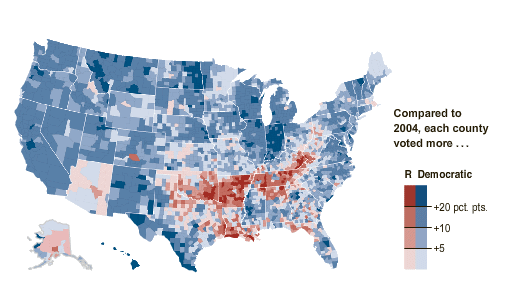 |
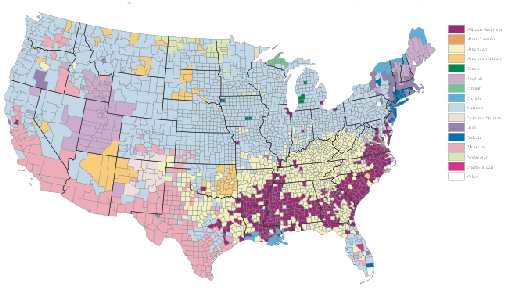 |
Several days ago, I was interested in the graphic on the left above. It was in the NYT and showed the places that were more Democratic in 2008 than 2004 in blue and the places that were more Republican in 2008 than 2004 in red.While I first thought of the red swath as the Bible Belt, I changed my mind. Looking at the graphic on the right that shows the dominant heritage by county in the U.S., it appears that the increased Republican vote is in the yellow area ["American" – meaning Scotch-Irish-English early settlers] except when overshadowed by the purple area ["African"]. I concluded that the map showed that racism/racialism still characterizes the South – the red swath being the whiter part of the old South responding to Obama’s racial background.

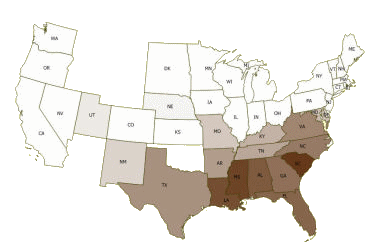
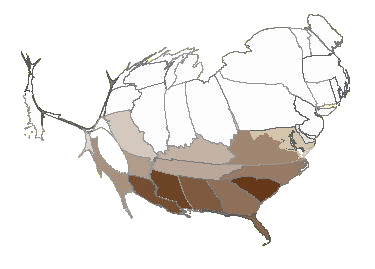
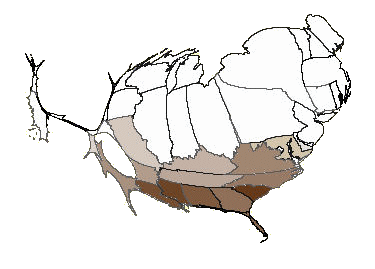
-
Abraham Lincoln: Candidate of the newly formed Republican Party wanted to abolish Slavery.
-
Stephan Douglas: "Northern" Democratic Candidate was racist, but supported new territories excluding Slavery.
-
John Breckinridge: "Southern" Democratic Candidate supported Slavery including the territories.
-
John Bell: The Candidate of the Constitutional Union Party who wanted to keep the Union by ignoring the Slavery issue altogether.
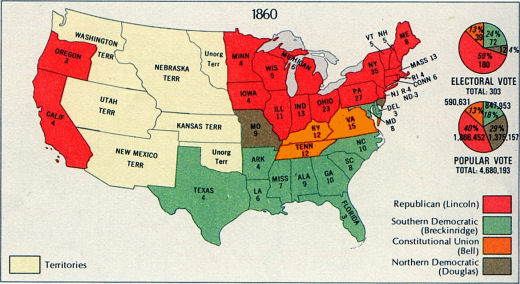
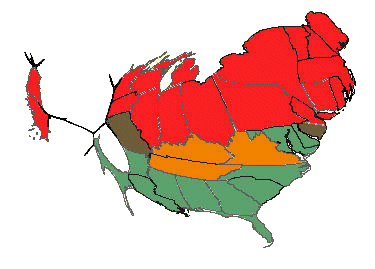
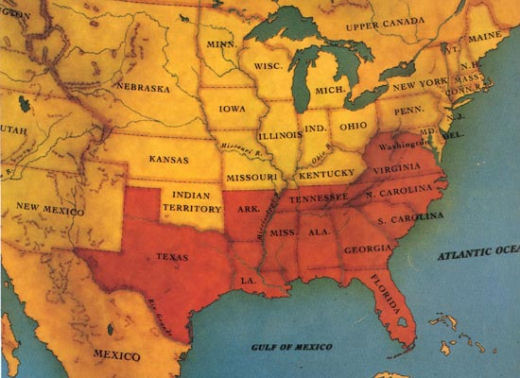
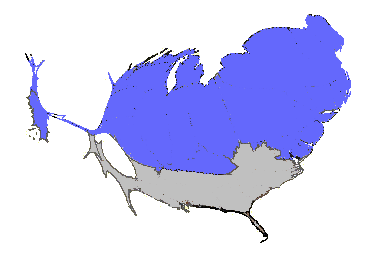
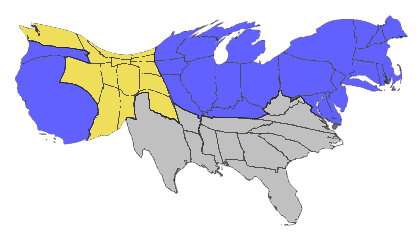
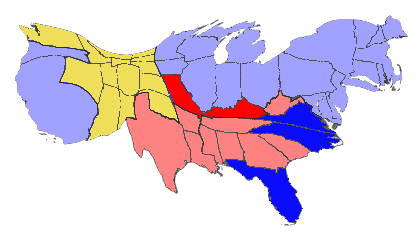
So, what did I learn from looking back to the 1860 Presidential Election and the demographics of that period? One thing I learned was how to make cartograms – fun, but hardly a marketable skill. Another thing is obvious – that I personally consider any place being more Republican in 2008 than in 2004 to be irrational and in need of explanation. This Republican Administration has been so destructive and so inept that I "hold [that] truth to be self-evident."
In researching around, I was blown away by the magnitude of Slavery in the "Old South." I don’t guess I ever thought about the fact that nearly half of the population were Slaves. Just saying it is still a bit breathtaking. Thinking of voters, that means that if you subtracted Slaves and Women from the adult population, one could hardly call my part of the country "A Democracy" in 1860. At that point in history, Slaves were a commodity, an essential commodity at that, being the engine that drove the cotton and other agricultural industries of the South. So the Democratic Party was the Party of the businessmen who controlled those industries.
I’ve always wondered why the foot soldiers in the Confederacy even fought in the Civil War. They got no personal benefit from Slavery. That was for the minority of rich plantation owners. The rank and file white southerner was poor, uneducated, eeking out an existence from the land. But they fought and died by the thousands. I know growing up, the Civil War was not about Slavery or Racism in my mind. It was about regional pride of some kind. It was only late when I became involved in the Civil Rights Movement that I even really knew that the war had been primarily about Slavery. I’m sort of ashamed that I didn’t know that, but it’s just how it was. In the South I grew up in, it had been about honor and tradition. I kind of think those poor whites [the yellow in the image at the top right of this post] were fighting for some kind of rugged pioneering ideal, something hard to put into words, some myth that’s still a part of southern culture. And I wonder if those foot soldiers weren’t fighting with some notion that if Slavery were abolished, their homeland would be "invaded" by the freed Slaves [who were already there]. That’s how many rural southerners still act [the "yellow" swath that voted "more Republican]." The notion that african american southerners are "foreign" is absurd, but it feels like that’s the background idea behind those red votes.
It’s discouraging how little progress we’ve made in the South in 150 years – voting nearly identically in 1860 and 2008. On the other hand, the first 100 years of that period were in a Segregated Society – locked into the pattern prevalent in 1860. It even seems slow for the last 50 years [my adulthood], but I suppose old patterns are slow to change. All of this frames how truly historic this 2008 election of an african american President really is. It’s been a long time coming. The tragic flaw of Slavery in a nation proclaiming that "all men are created equal" remains a major force in our Union now 232 years after its founding.
And I found myself wondering how the Republican Party, the Party of Lincoln, went from being the Abolitionist Party in 1860 to the Conservative Businessman’s Party in 2008[1]. As always, looking into one thing only brings up questions about another thing. Time for another historical plunge, I guess. When did the South move from solidly Democratic ["Dixiecrats"] to solidly Republican? That one is easy. 1964 – with Lyndon Johnson who enacted the Civil Rights Legislation and the Black Mississippi Freedom Democratic Party which was seated at the Convention. One thing for sure – without what remains of the solid South, the Republican Party is headed for dark days. If you didn’t know what that last cartogram was, you might see red as Slave States and blue as Free States. And today reminds me of 1860 in another way. I see the War in Iraq as a businessman’s war – a war for oil. And, like in the Civil War, the foot soldiers and the majority of the Republican voter base are not the people who might benefit. Very interesting. Very confusing.
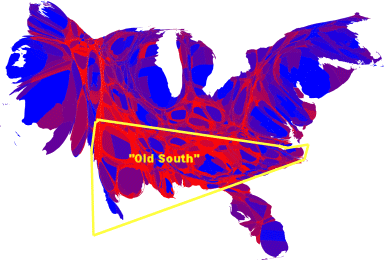
Man, Mickley, that is one impressive bit of research and computer wizardry — way beyond my capabilities. But very instructive.
Interesting about what we knew about the Civil War growing up. In my case, in a small town in middle Georgia, I think I always did connect it with slavery. Or at least I have a pretty early memory of being shown the “slave market” in a neighboring town and being horrified to realize what actually happened there.
But I may be projecting backward from at least teen years. I know other people tried to paint this picture about it wasn’t really about slavery but about states rights and honor and all that. But somehow I absorbed pretty early that that was putting lipstick on the pig (to borrow a phrase).
I unofficially volunteered for SNCC as a High School student from a suburb outside of NYC. I did it without my parents knowledge. My Mom found SNCC posters under my bed and I was forbidden to do anymore volunteering. Theo Bikel had introduced me to volunteering for SNCC. I went to work for Western Electric in the late 60’s in Newark, NJ and found myself smack in the middle of the Newark riots. It was scarey with fire and gunshots all around us when we went to work on the bus to and from work. I was on a leave of absence from the convent at the time. I ended up falling in love with a Jewish engineer and 2 sons and 35 years later here we are talking about the Civil rights movement.
[…] done to move them in a more positive direction. That’s what I was trying to do in the post, looking back [1860]… [the one with all the cartograms]. But I wasn’t clear about what problem I was thinking about […]
[…] to the worst in people – one that apparently still works down here [ the divided South…][looking back [1860]…]. Whether he recanted when he was dying is essentially immaterial. His legacy lives […]
[…] December 2008 After the election, I found myself musing about The South – my own beloved country (looking back [1860]…). I concluded: We think of politics in contemporary terms, but much of it is deeply embedded in […]
This is a very interesting website. Do either of your cartograms for the 1860 election take into account the effects of the 3/5 compromise? According to this compromise (part of the Constitution since its ratification in 1789), 3/5 of each slave counted toward a state’s population for the purposes of representation in the House of Representatives. This means that slave states also had more electoral votes than their white/voting population would have justified, since they got more representatives because of their slave populations. So it would be interesting to have two electoral cartograms for 1860: one that figures out how many electoral votes the states in the South had with 3/5 of their slave population counted, and then one that shows how many electoral votes the states in the South would have had WITHOUT 3/5 of the slave population counted. I think we would see a dramatic difference – the South had many more electoral votes in 1860 than its white/voting population warranted. Although I don’t know if this would change your overall analysis, it might add an interesting historical dimension to your site.
awesome post! good read